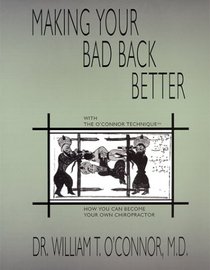Search -
Making Your Bad Back Better, with The O'Connor Technique : How You Can Become Your Own Chiropractor
Making Your Bad Back Better with The O'Connor Technique How You Can Become Your Own Chiropractor
Author:
MAKING YOUR BAD BACK BETTER WITH THE O'CONNOR TECHNIQUE, HOW YOU CAN BECOME YOUR OWN CHIROPRACTOR is a unique spinal pain relief educational treatise and self-help manual that begins by describing the state-of-the-art with respect to back pain management and briefly elaborates on historical, contemporary, practitioner-mediated and self-administe... more »
Author:
MAKING YOUR BAD BACK BETTER WITH THE O'CONNOR TECHNIQUE, HOW YOU CAN BECOME YOUR OWN CHIROPRACTOR is a unique spinal pain relief educational treatise and self-help manual that begins by describing the state-of-the-art with respect to back pain management and briefly elaborates on historical, contemporary, practitioner-mediated and self-administe... more »
ISBN-13: 9780966499117
ISBN-10: 0966499115
Publication Date: 2/1/2000
Pages: 402
Rating: ?
ISBN-10: 0966499115
Publication Date: 2/1/2000
Pages: 402
Rating: ?
0 stars, based on 0 rating
Publisher: Aegis Genomics Corporation
Book Type: Paperback
Members Wishing: 3
Reviews: Amazon | Write a Review
Book Type: Paperback
Members Wishing: 3
Reviews: Amazon | Write a Review
Genres:
- Health, Fitness & Dieting >> Exercise & Fitness >> Injuries & Rehabilitation
- Health, Fitness & Dieting >> Diseases & Physical Ailments >> Backache
- Health, Fitness & Dieting >> Diseases & Physical Ailments >> Musculoskeletal Diseases
- Health, Fitness & Dieting >> Diseases & Physical Ailments >> Pain Management
- Health, Fitness & Dieting >> Alternative Medicine >> General




